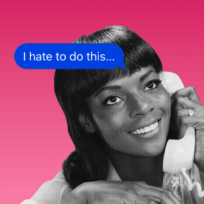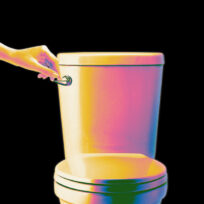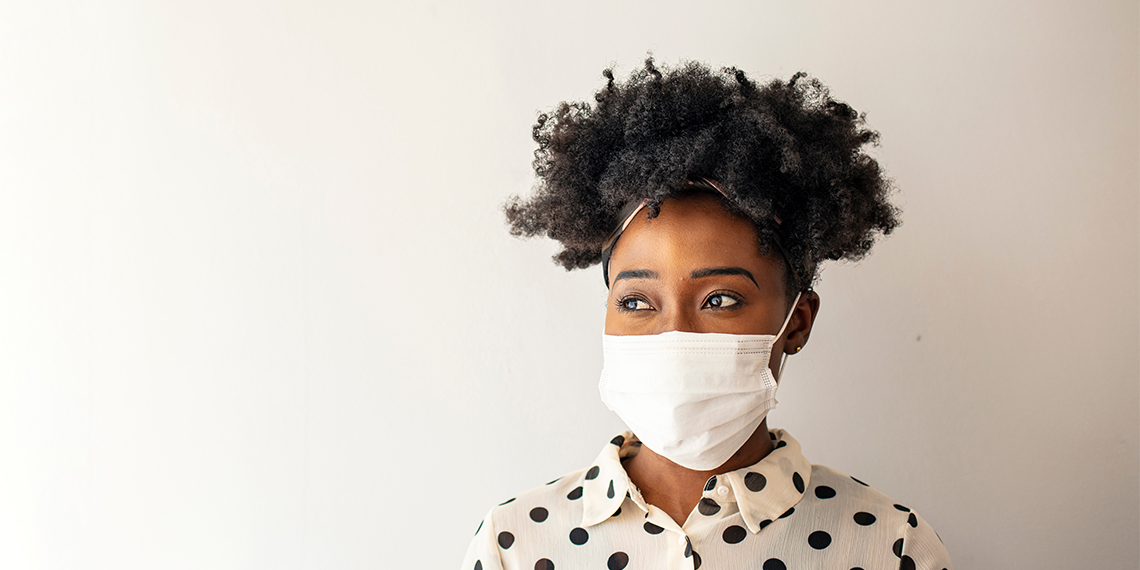If your Facebook timeline looks anything like mine, you’ve spent the past few months scrolling past pictures of your friends’ houses, a lot of politics, and that one freaking person who will not stop posting misinformation and conspiracies about masks. Whether this person is screaming into the void that masks are yet another tool for government control (if only we would just OPEN OUR EYES), or this well-meaning but ill-informed friend is trying to convince you that masks themselves are a danger to your health, there is no shortage of misinformation out there.
As frustrating as it is to see post after post about the horrors of masks, it isn’t entirely surprising. According to a paper by psychology professor Monika Grzesiak-Feldman, increased fear and anxiety make it more likely for a person to believe conspiracy theories and misinformation. When you feel threatened, you often feel out of control—belief in conspiracies, regardless of how baseless the theories are, gives you the (misguided) sense of control that you’re so desperately seeking. A need for control over your surroundings combined with a deep need to make sense of the world around you can lead to misinformation spreading like wildfire, simply because people are fiending for answers.
Imagine you’re standing up against a wall with nowhere to run, and a hundred little kids with water balloons show up and just start firing. That’s us, every single day, with the incredible amount of information (both accurate and inaccurate) being lobbed constantly in our general direction. We can’t avoid the information tornado that we exist within, but we can cope with it. How? Well, by doing the equivalent of wearing a raincoat during a water balloon attack. We have to protect ourselves. This isn’t easy, it involves treating every piece of information thrown your way like a telemarketer trying to sell you a problem-solving pill. Repeat after me: NOT EVERYTHING YOU READ IS TRUE. Ask yourself a few simple questions to figure out if whatever you’re reading is reliable. Who is writing this article, are they credible? Do they have some sort of expertise in this area of study? Why are they writing this article, what are their motives? And perhaps the most simple, yet inexplicably complicated question, does this even make logical sense (looking at you, “5G caused a pandemic people)?
One of the most prevalent subjects of conspiracy theories and misinformation in the past few months is none other than the ever-present face mask. Again, this whole situation is extremely stressful. Anxiety is high, and truthfully, we don’t know exactly what’s going on. I hear you, that’s scary. However, failing to use masks (or failing to use them effectively) is going to keep us in this situation for even longer. It’s ok if you’re glaring at me through your screen right now. Stick with me—I promise to act as your information poncho for the next several paragraphs, and we’re using trusted experts to debunk some of the most common mask myths.
Myth #1: Wearing A Mask Reduces Your Oxygen Levels
Before we get to the experts, please remember that medical professionals have been wearing masks for hours at a time long before the pandemic started. The very people responsible for understanding and helping us take care of our bodies are using masks every single day with no serious issues. I say “no serious issues” because there are absolutely non-serious issues. For example, masks are uncomfortable. They get sticky and humid and it really might feel like your mask is inhibiting your breathing. Spoiler, it’s not. In an interview with Animal Político, Dr. Daniel Pahua Díaz, an academic from the Department of Public Health at the National Autonomous University of Mexico medical school explained, “This misinformation may arise from the feeling of lack of air due to mechanical obstruction depending on the type of mouthpiece we are using. But the feeling of obstruction is because we are not used to using the mouth mask. But as such it will not cause us any kind of hypoxia.” Hypoxia, meaning lower levels of oxygen.
If you need more proof, a doctor in Ireland set out to disprove the myth himself. He put on not one, not two, but six face masks. His oxygen levels were unchanged. Assuming you’re not wearing seven face masks, or using a mask made of some sort of metal, wearing one for a few hours at a time isn’t going to impact your oxygen levels.
Getting asked
“Does wearing a face mask lower your oxygen levels” repeatedly by patients today!
Based on what they are reading on social media
*Face coverings / masks don’t reduce your oxygen levels!*
I managed to get six face masks on + it had no effect on my oxygen levels! pic.twitter.com/qNKYa8pejx
— Maitiu O Tuathail (@DrZeroCraic) July 14, 2020
Myth #2: Wearing A Mask Causes Carbon Dioxide To Build Up In Your Body
I, for one, have seen more than my share of posts claiming that wearing a mask can cause you to drop dead of carbon monoxide toxicity. As with the oxygen myth, it’s important to remember that MASKS WERE CREATED TO ALLOW US TO BREATHE THROUGH THEM (I’m not screaming, you’re screaming). It is true that too much carbon dioxide can cause hypercapnia (a fancy word for having too much CO2 in your blood), but it’s really unlikely to occur from regular use of a mask. A CDC representative explained to Reuters, “The CO2 will slowly build up in the mask over time. However, the level of CO2 likely to build up in the mask is mostly tolerable to people exposed to it. You might get a headache but you most likely [would] not suffer the symptoms observed at much higher levels of CO2.” A simple solution to even a small buildup of CO2 in your mask is to take it off (in a safe place, with clean hands) every once in a while.
Myth #3: If My Mask Is Covering My Mouth, I’m Safe
Ok, I’m taking some creative liberties here because I’m not sure that anyone consciously believes that a mask covering your mouth is effective. Here’s the thing, though, I have seen countless people in stores, in memes, all wearing masks with their noses still completely exposed. With all due respect, f*cking what? We know that this virus spreads through droplets, ones so small that they are invisible to the naked eye. These droplets leave our bodies when we talk, sing, or even breathe. If we inhale someone else’s droplets, through any hole (mouth or nose, relax), we invite potentially infected particles into our bodies. An article from the Cleveland Clinic explained, “A mask should cover your mouth and your nose. It should be snug but comfortable against the sides of your face, and you should be able to breathe without restriction. Choose one that secures with ties or ear loops. Don’t wear your mask around your neck or chin, or over your head—that doesn’t protect anyone.”
Myth #4: I Don’t Need To Wear A Mask Around Healthy People
A few of your friends want to have a little get-together. Just the four of you. I mean, you’ve been cooped up for so long—and it’s your birthday! You deserve a little treat, right? Just one day of pretending the world isn’t crumbling is exactly what you need to keep your sanity. I say this with all the love in the world: don’t trust your friends. Regardless of how careful your friends think they’re being, there is room for error. An almost imperceptible scratch of the nose after opening their contaminated car door, forgetting a mask once while walking their dog, there are so many ways to contract COVID that the safest bet is to assume that everyone (including yourself) is infected. Even more frightening than the ease with which the virus spreads is the fact that seemingly healthy people may not only be infected, but incredibly contagious.
Monica Gandhi, an infectious diseases physician and researcher at the University of California, San Francisco clarified some things about asymptomatic transmission (the spread of COVID by people who aren’t even showing symptoms) for The Conversation. She explained, “Researchers have found that pre-symptomatic people shed the virus at an extremely high rate, similar to the seasonal flu. But people with the flu don’t normally shed virus until they have symptoms.” She continued, “When people cough or talk, they spray droplets of saliva and mucus into the air. Since SARS-CoV-2 sheds so heavily in the nose and mouth, these droplets are likely how people without symptoms are spreading the virus.”
Even if your friends seem completely healthy, there is just no way to know for sure, short of having everyone flash their negative COVID test results on their way inside. Symptoms can appear as long as two weeks after infection, or sometimes not at all. This means that people walking around looking perfectly healthy can be huge transmitters of the disease, since they’re under the assumption that they’re not even infected. Assume everyone you encounter is sick. End of story.
Myth #5: Cloth Masks Are Ineffective
According to the most recent research, scientists say that cloth masks are just fine for the general public. While they are not as effective as masks with filtration elements such as the N-95, they do an adequate job at blocking particles from entering or exiting to protect both the wearer and those around them. According to a recent study, cloth masks provided about half the protection of medical-grade masks. Practicing social distancing and staying away from large crowds will provide the wearer with even greater protection.
Infectious disease specialist Peter Chin-Hong, MD explained in a University of California San Francisco article, “The concept is risk reduction rather than absolute prevention. You don’t throw up your hands if you think a mask is not 100 percent effective. That’s silly.”
He continued, “Nobody’s taking a cholesterol medicine because they’re going to prevent a heart attack 100 percent of the time, but you’re reducing your risk substantially.”
Part of the reason there is so much mistrust and confusion about masks is because for a while, we were given conflicting information. The experts were trying to figure things out as quickly as possible in an urgent situation—this means that some of the information we may have received initially is no longer valid. (Like when experts were initially concerned wearing a mask would do more harm than good because it would cause people to touch their faces more.) Dr. Moshe Lewis, a San Francisco doctor who specializes in physical medicine and rehabilitation explained to Healthline, “Science is complex, and when the public sees it unfold on a grand scale in front of their eyes, confusion ensues. Various recommendations were put forth and then retracted, leading to mixed messaging. From these embers, fear, facts, and fiction get spliced into controversy.”
The best plan? Stay up-to-date on research from trusted experts to get the most accurate information and, for the love of God, please stop getting your medical advice from Facebook memes.
Images: Dragana Gordic / Shutterstock; drzerocraic / Twitter



















































